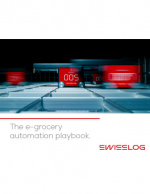A Guide to E-Grocery Fulfillment Strategies and Technologies
This e-book looks at how COVID-19 has become a major disruptor and is accelerating the need for automated e-grocery fulfillment.
E-commerce has been a highly disruptive force in the retail sector over the last 10 years, rapidly growing to account for up to 20% of total sales. The grocery sector has largely been immune to this disruption, with only about 3% of grocery spending in the U.S. occurring online in 2019.
That is changing — and quickly. Demand for e-grocery services was already surging prior to the global pandemic that spread in the first quarter of 2020. Coming into the year, many analysts were predicting that e-grocery services had hit a tipping point and the industry was on the brink of the same type of disruption other retail sectors have experienced.
The aggressive growth projections analysts made coming into 2020 suddenly looked timid in light of potential long-term behavior changes resulting from the global COVID-19 pandemic. The pandemic spiked demand at the end of the first quarter of 2020 and overloaded many e-grocery fulfillment operations. A survey conducted at the end of March 2020 found that 65% of consumers had changed their grocery shopping behavior as a result of the virus. Almost overnight, fulfillment times for e-grocery orders went from same-day to more than a week in some areas.
With e-grocery sales reaching new levels faster than expected, grocers must finalize strategies for supporting same-day home delivery and curbside pickup. While there are multiple options to use the existing store network to support e-grocery fulfillment, automation is required to provide the necessary productivity and speed. Goods-to person automation systems have been proven in many warehousing applications and provide the density and flexibility required to support e-grocery fulfillment.
This new e-book, “A Guide to E-Grocery Fulfillment Strategies and Technologies,” looks at how COVID-19 has become a major disruptor and is accelerating the need for automated e-grocery fulfillment. It also examines the different strategic approaches that can be taken and the flexible automation technologies and software that can be quickly deployed.
What’s Related




Favorites





